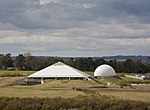Avington Park

Avington House is a 16th-century English country house which stands in Avington Park in the Itchen Valley near Winchester, Hampshire. It is a Grade I listed building.Originally a late 16th-century half-H house built by John Clerk it was substantially rebuilt in the 17th century by George William Brydges, who added the service courtyard and banqueting hall. It was then refronted in the late 18th century by James Brydges, 3rd Duke of Chandos. In 1848 Sir John Shelley added a conservatory. The building is now constructed of brick and blue with slate and lead roofs. The half-H main block is in two storeys with a 13-bay frontage, of which the central 5 bays are recessed.
Excerpt from the Wikipedia article Avington Park (License: CC BY-SA 3.0, Authors, Images).Avington Park
Winchester Itchen Valley
Geographical coordinates (GPS) Address External links Nearby Places Show on map
Geographical coordinates (GPS)
| Latitude | Longitude |
|---|---|
| N 51.0877 ° | E -1.241 ° |
Address
Avington Park House
SO21 1DB Winchester, Itchen Valley
England, United Kingdom
Open on Google Maps









